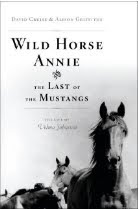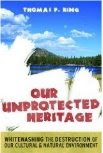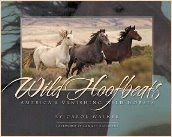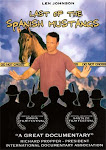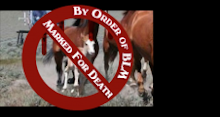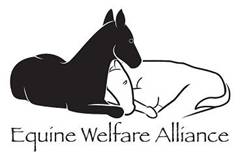As I perused through BLMs electronic maze of carefully crafted “strategies”, I couldn’t help but wonder about the thousands of public comments already submitted to BLM that have disappeared into the bureaucratic vacuum of BLMs vaults.
In case you are wondering what I’m talking about, shortly after BLM Deputy Director Henri Bison announced to the National Wild Horse & Burro Advisory Board in June 2008 that BLM was now considering euthanizing thousands of now captive American mustangs to cut Program costs, BLM initiated a “Public Comment” format on their website that supposedly accepted public comments and input for consideration in future management strategies of our mustangs and burros.
This opportunity was available to the public for almost two years, (based loosely on my memory) and yet, looking at BLMs newest sales attempt for “public involvement”, I couldn’t help but wonder; where are all the previously submitted public comments and suggestions in the current “Strategy Development Document” BLM plans on parading around and using to show Congress how much they really do care. Really…
After all, BLM has cared so much about what the public had to say back then (and now) that all those comments just disappeared while BLM was able to create the illusion of doing something -but this time it’s different, right?
BLM also cares enough to limit the current line of questioning and obviously manipulated public responses to merely a handful of Salazar approved themes. And if that isn’t enough, not only did BLM make every public comment and suggestion disappear from the last round of public input, they intend to limit the scope of this round of public comments to merely summaries of our thoughts - rewritten at their discretion for the new Strategy Development document - in BLM’s latest updated version of the public involvement hoax.
Well here’s an idea to promote the BLM transparency they claim they are reaching for: How about someone submitting a FOIA to BLM regarding all the public comments, suggestions and ideas previously submitted in order to review how much they incorporate them in the “new” strategy.
So this is what I have to say to Congress and BLM about their management of the Wild Horse & Burro Program, Salazar’s Initiative, and what “we, the people” have received over the last forty years for their efforts….
> A loss of at least 21.7 million acres of supposedly “protected” wild horse and burro habitat with no call by Congress for initiating a serious investigation of where it went or for making any sincere efforts to initiate its rightful return. (But Congress certainly seems willing to seriously consider buying a whole bunch of private land to the tune of millions of dollars to stockpile sterile wild horse herds on without any additional review, right?)
> BLM admitting they can’t count the number of horses on the range within even a marginal degree of accuracy. (Editor's Note: Don't be fooled by BLMs reference to the GAO conclusion about their inability to count horses. The GAO's conclusion was reached after tallying survey responses sent back from BLM offices - that's the only "evidence" the GAO has...)
> BLM also being unable to even marginally count or report the number of wild horses and/or burros in the equally mysterious holding facilities as recently evidenced by Equine Welfare’s Alliance newest press release, "How Do You Make 2000 Horses Disappear? Let BLM Manage Them" (plus supporting documents), which clearly show how over 2,000 horses are now missing from BLM Holding Facility Chart Reports. (Editors Note: This is the second time massive discrepancies have been found in BLMs publicly reported Holding Facility numbers as a similar discrepancy of approximately 1,700 wild horses was found less than six months ago.)
> Last October, BLM also publicly released the Fiscal Year 2009 “Final” Gather Schedule that is suppose to detail all the removals BLM performed over the fiscal year; except it initially failed to included approximately 2,900 wild horses BLM had removed in October, November and December.
> Recently, BLM Public Relations Specialist JoLynn Worley explained via email that the population BLM had been reporting for Toano Herd Area since 2004 was merely another accounting “error”; despite Ms. Worley providing maps of the Toano Herd Area that now report BLM conducted aerial censuses in both 2006 and 2007 that found zero wild horses. (Editor's Note: The maps Ms. Worley provided to prove this were created on July 9, 2010 – the day before the Pilot Valley “estray” horses were sold at a livestock auction in Northern Nevada). Setting those questions aside for the moment, BLM now claims they went ahead and kept reporting and adding wild horse populations they “knew” didn’t exist to National totals. By my understanding, this kind of accounting practice is clearly defined as fraud. Of course, I’m sure BLM will be excused for their bad record keeping again (and again, and again, and again, and again, and again, and, well, you get the idea…)
> BLM cares so much about the integrity of their stewardship for our wild horses and burros that in their new Wild Horse and Burro Handbook, they refer to them as "feral" while the majority of established Appropriate Management Levels (AML) used to determine “excess” horses are so convoluted, filled with errors, omissions and manipulation of data, that the sheer audacity of their incredulous statements borders on the obscene. Still, BLM maintains these AMLs are accurate and horses exceeding these AMLs must be removed under an “excess” clause; despite the magical appearance of thousands of horses and burros they never knew were out on the range to begin with prior to the pre-gather aerial censuses. Click Here to view an updated chart on how often this has now happened.
> BLM cares so much that, throughout the course of its management of the Wild Horse and Burro Program, there have been extreme allegations of abuse, inhumane treatment, sanctuary schemes, selling wild horses for slaughter, using phony double branding systems, black booking operations and “slicks” (see 1997 PEER Report; Horses To Slaughter - Anatomy of a Cover Up) as well as reports surfacing that approximately 32,000 wild horses were already missing from BLM records as far back as 1998. (see 1998 Range Issues Field Hearing before the Subcommittee on National Parks and Public Lands).
> BLM cares so much that it has spent the last 8 years ramming through Resource Management Plans and AML decisions that completely zeroed out herds with little to no rangeland evidence to support those decision (for starters, see Ely Resource Management Plan or the West Douglas Herd Area) or choosing to bury monitoring data from their own Wild Horse & Burro Specialist that testified under oath that rangeland health objectives were being met - despite wild horse populations being significantly over BLMs mythical AMLs.
> The BLM also cares so much about their stewardship duties that they believe they are the supreme authority on all aspects of the Program and so, can ignore federal judges opinions, block public access to gathers, holding facilities and census flights as well as continuing to post multiple errors in their Wild Horse and Burro Statistics without any concern of accountability or oversight.
> And lately, BLM also seems to care quite a bit about “bad press” and has become concerned that the time honored tradition of successful sound byte regurgitation's of "overpopulation", "degraded ranges" and "emergency humane gathers" may be losing some of its iron grip acceptance by the masses due to grass roots efforts to expose the truth. In response, BLM has now launched an impressive cadre of upbeat, up-to-date, technologically savvy public “outreach” programs that include Twitter, Facebook and their very own YouTube Channel!
Too bad they couldn’t have devoted the same time, effort and money towards promoting wild horse and burro adoptions, huh? (see BLM's National Wild Horse Adoption Day).
Let’s face it, over the decades, the long string of Interior and Agriculture Secretaries have unequivocally failed both public and law on every level. Now, they want to know what we think about that fact….
Currently, BLM is soliciting public input on where to go with the Wild Horse & Burro Program – again.
The deadline to respond is August 3, 2010, and you can do this by either trying to jump through the BLM's insane website hoops or by sending a written letter to the Washington Office.
Right now, a lot of organizations and blogs are stressing the need for advocates to send their comments via the old fashion way, by snail mail. Why? Because if you mail your comments in, you won’t be as restricted as if you try to navigate the narrow canyon BLMs “input system” tries to herd the public through.
In Defense of Animals has put together a great response, including a letter that you can print and send to Washington, which include many key points that reflect the abysmal efforts of “Salazoo’s Initiative” he is hoping he and Obama will be able to smooze through Congress. So maybe you may want to use this method to speak up for our horses and burros. Or maybe, you’d just rather submit your own kind of input instead.
However, whatever way you decided to go, here’s a word of caution;
If you choose to mail your comments in to the Washington office, due to the high level of security hard copy mail must go through in the DC area, it may take several weeks before BLM finally receives your input.
Therefore, I would HIGHLY recommend you send any comments Return Receipt Requested so that,
a) You have a dated receipt and postmark that proves you submitted comments prior to the deadline and,
b) You know for sure BLM received your comments and if necessary, can prove that as fact in a court of law.
As for me, after what I have had to witness over these last four years of my “public involvement” with BLMs management of the Wild Horse & Burro Program, the only really sincere suggestion I have left to give is to tell Congress-
"Don’t wait for BLM to submit their resignation, give them the pink slip NOW!"
Click Here to review my personal input and submission.
~Mailing Address~
Wild Horse & Burro Strategy Development Document
BLM Washington Office
1849 C Stree NW, Rm. 5665
Washington, DC 20240
!NEW EMAIL ADDRESS!
wildhorse@blm.gov
With five days left of the public comment period, AWHPC has reported BLM finally released an easy to use, functional email address. Personally, knowing how BLM is, I wouldn't leave it to chance and recommend sending a hard copy via postal mail anyway just as a "back up" plan!
7/30/10...BLM Announces 30 Day Extension of Public Comment Period
7/31/10...BLM Extends Comment Period But For Who's Benefit,
Not The Wild Horses
Straight From The Horse's Heart: R.T. Fitch


